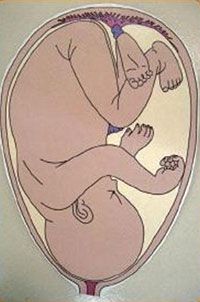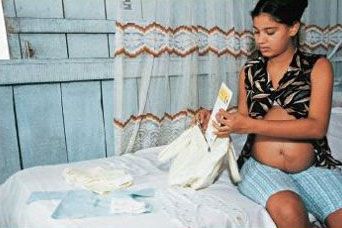Talking about the baby
To assess and celebrate
• How was the visit to the pregnant woman?
• What do you think about your work at the Child’s Pastoral?
• Share with the group the emergency plan that you have made.
• Is there any message, prayer or a biblical quotation which celebrates the gift of life and the actions that we have performed with our next, the pregnant woman and her families? A suggestion is:
“Of all women you are the most blessed, and blessed is the fruit of your womb.” Luk 1:42
To See
The seventh, eighth and ninth pregnancy month, the labour and the childbirth
1- What would the pregnant women of your community like to know about the labour and the childbirth?
2- Does the health system of the municipality ensure a quality assisted labour to the pregnant women?
In the seventh pregnancy month, the baby already measures around 40 centimetres and weighs more than a kilo. His/her brain is bigger, he/she feels pain and perceives strong light close to the mother’s belly.
As of the eighth month the room occupied by the baby is no longer as spacious as it was before and usually the child begins to position the head down preparing for childbirth. Thus, the mother’s bladder is pressed down and she has more need to urinate/pee.
In the last pregnancy month, the baby weighs approximately three kilos and three hundred grams (3.300 g) and his/her size may vary from 48 to 52 centimetres depending on the gender.
It is good that the parents talk to the baby, expressing how they are feeling now that the birth is closer. This will be creating a love bond with the baby and will strengthen the relationship between the child and the parents after the childbirth.
Leader, in this pregnancy phase, the baby will gain around two kilos, in other words, the largest part of his birth weight. Therefore, it is very important that the mother gains weight in these pregnancy months.
Talking about the pregnant woman

Foto:
In this last quarter, the pregnant's breasts veins are showing more. The belly is larger, the belly bottom can be apparent and the womb pushes the rib and squeezes the lungs.
Each pregnant woman has a different belly: this varies according to the woman’s body structure, to the weight increase during pregnancy and also to the size of the baby.

Foto:
In the last three pregnancy months, the pregnant woman should work less and rest more. If she does hard work and become very tired, the baby may be born ahead of time. Therefore, the pregnant woman needs to have more help from the partner and the family with the housekeeping or with whatever is necessary.
It is good that the pregnant woman sleeps on her left side. Thus the womb weight will not press the main belly veins.
Breastfeeding

Foto:
The wish to breastfeed is the main factor for successful breastfeeding. Other factors that influence the pregnant woman are: the mother’s effort, the support she receives in the first days and finding the baby’s right mouth sucking position in her breast.
The visits of these last months are ideal to explain to the pregnant woman about the baby’s right mouth sucking position in her breast and how to do the evacuation of milk from her breast trough the milking procedure. Thus she gets more prepared and at ease for the first breastfeeding. The baby’s right mouth sucking position is explained on the page 112 and the milking procedure on the page 170.
During the conversations, besides encouraging the pregnant woman to breastfeed her baby, it is also good to know what she feels and thinks about breastfeeding in order to be able to help her according to her needs.
Mothers of the first child may fear of not being able to breastfeed. Mothers, who did not have good results in breastfeeding her other previous children, will need support to be able to breastfeed their new baby. A good help is to promote the contact of the pregnant woman with mothers that have already breastfed or who are still breastfeeding.

Most common complaints
Pains in the back and tiredness
In the last pregnancy months the woman becomes more tired and has pains in the back because of the spine position. The pain in the belly’s lower part is caused by the baby’s weight in the womb. In order to relieve these discomforts she needs to rest with the legs raised up several times during the day.
Sleeping difficulties and concerns
Sometimes it is difficult for the pregnant woman to find a comfortable body position to sleep because of the belly size. It is good to recommend that she lay down on her left side and that she put pillows to support and to reduce the discomfort. When the sleep is also disturbed by the concern with the labour, she should breathe slowly and deeply before sleeping to help to relax and to improve the sleep.
Leader, you may advise the pregnant woman to talk about her anguishes to her partner, to the family or to you, leader, because this usually helps to diminish her concerns.
A swollen belly
A swollen belly usually tends to appear after the meals. Leader, in this case, advise the pregnant woman not to drink liquid during the meals, to eat little and more often as well as to change the way to prepare the food, making it more liquid or pasty. When doing so the digestion gets easier.
Attentionn: If the pregnant woman does not feel the baby moving inside the belly or if the baby gets very agitated for more than half an hour, go to hospital immediately.
Delivery signs

Foto:
Some weeks before the labour, the pregnant woman’s body goes through transformations to get prepared for the childbirth;
• The baby gets to the lower part of the mother’s belly, what causes a pressure in the lower part of her abdomen, sometimes it is followed by a pain in the back;
• The contractions, which until then were weak and with no pain, now begin to be more intense;
• Vaginal secretions come in a bigger amount, sometimes in a pinker colour because of the rupture of some veins.
• This is caused by the baby who is moving down to the lower part of the abdomen getting to the birth position.
Leader, in the last three pregnancy months the pregnant woman should avoid heavy work. When she does heavy work and gets tired the baby may be born ahead of time. However, doing light work and exercises helps the delivery.
Delivery plan

Foto:
Leader, in the last visits to the pregnant woman before the delivery, it is advisable that you talk more to her and her family about the arrangements for the delivery day and about the baby’s birth.
You may ask the pregnant woman if she has already a hospital for the delivery. If she lives far from the hospital, you should recommend that she be lodged in a place closer to it when the delivery date comes closer. If she already has other children it is important to arrange with a relative or a friend of hers to take care of the other children while she is in hospital.
Also talk about the delivery methods. Explain that the best method for the baby to be delivered is the normal way, (through the vagina). When the baby is delivered this way, the baby is more active and wishes to suck the colostrums already in the first hours after the birth (see page 97).
The normal delivery is also the best method for the mother. She feels less pain after the childbirth and recovers faster. Thus she feels stronger to take care of herself and the baby. The Cesarian method, a surgical incision, shall only be taken if necessary.

Foto:
When the time comes to go to the hospital, the pregnant woman shall take with her:
• Her Pregnant Woman’s Card;
• A personal document – such as the identity card, labour card, marriage certificate or birth certificate;
• A bag with her clothes, pads and some baby clothes;
The partner, the family members or the friends that live nearby must know about the labour signs (page 90) and where to take the pregnant woman. Thus they will feel safer to go to hospital at the right time.
The signs that show the delivery time is coming may vary from woman to woman and also from one pregnancy to another. In general the labour of the first child takes longer time than the second
Visiting the Health Service Unit
Leader, visit the health service unit of your community. Introduce yourself and tell a little about the Child’s Pastoral Program conducted in the communities through the volunteers. Try to know and write down the information below to better guide the pregnant women who you follow:
• The name, address and telephone of the Health Service Unit
• How is the prenatal check done? (day/time/the check procedure; name of the doctor/nurse)
• Where are the blood and urine tests collected?
• Is the Pregnant Woman’s Card available? Has the womb height been measured and written down on the Card?
• Is the doctor who does the prenatal check the same doctor that assists the delivery?
• How is the vaccination plan against tetanus performed in the municipality?
According to what has been seen, talk to each pregnant woman about her delivery plan:
1. Which is the hospital chosen by the pregnant woman to give birth?
2. Who shall the pregnant woman take to hospital when the delivery time gets closer?
3. Who shall take care of the other children while the mother is in hospital?
Home Visit
During the visits it is very important to:
Deliver and read with the pregnant woman the Love Bonds Cards regarding her current pregnancy month;
Ask the pregnant woman if she has any complaint or concern and how you can help her;
Talk about the danger signs (page 77);
In the 9th pregnancy month:
talk about the delivery plan;
explain to the family the delivery signs (page 90);
deliver and also talk about the card “The baby is born”;
teach the pregnant woman how to start breastfeeding.
Answer the questions of the Leader’s Notebook.



